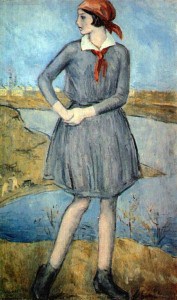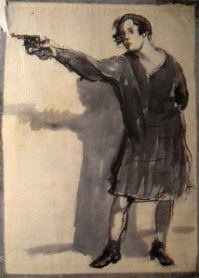
This image, entitled “The Delegate” from the visual essay, “Models & Counter-models of Gender” within the subject of Revolutionary Manliness reminded me of Liuda in the silent film, “Bed and Sofa.” This image depicting women in the communist 1920’s is grouped with four others, each different from the next. Below are two starkly contrasting photographs, one depicting femininity and the other depicting ‘manliness’ and power in the holding of a gun.


The lack of consistency with these photographs of women represents the complexity of gender roles after the Russian Revolution. In the Bolsheviks attempt to move from socialism and onto communism, they recognized the need to change society in many ways as to better their collective self and experience (Freeze 329). They also knew that they needed vast state power, education campaigns and party organizations, among other things.
Two of these party organizations included the “Zhenotdel (Women’s Department) and the Komsomol (Young Communist League).” The Zhenotdel became very effective in organizing women at the local level which threatened Soviet leader’s hopes of “class solidarity,” thus the Women’s Department was shut down in 1930 (Wikipedia). The Komsomol, on the other hand, were not known to be as successful or productive; rather, they were known for their “atheism, hooliganism, and sexual depravity.” (Guillory) Further, the Komsomol was known for disregarding and harassing women. The gender roles in this instance, however, are not merely about men not respecting women but rather about how communism was characteristically masculine and thus women could not be a part of it. Now you can see how the pictures above show the complex gender roles of the time in that women saw themselves as powerful (Woman with a Gun) whereas men and the communist party viewed women as subservient and domestic (A Young Pioneer).
In the silent film, “Bed and Sofa”, Liuda plays the characteristic role of women in the eyes of men in that time. However, Volodya, a Mensehvik, saw Liuda as she wanted to be seen, someone capable of more than just tending to the household. His gift to her of newspapers and a radio showed his belief in women’s ability to be involved and aware of their government’s actions. Thus, there was some progress on the front of the perceptions of women’s newly gained rights of civil marriages, readily available divorce, legal equality, full rights to children born out of wedlock, and abortion. These newly given rights were an attempt by the new government to change the tsarist ways that were patriarchal, religiously sanctioned families (Freeze 331).
The Revolution, despite bringing about new women’s rights, created complex gender roles and altered the dynamics of family towards revolutionary values of relative freedom and away from tsarist societal values and norms.
Works Cited
Freeze, Gregory L. Russia: A History. 3rd ed., New York, Oxford UP, 2009.
Guillory, Sean. “Revolutionary Manliness.” Seventeen Moments in Soviet History, soviethistory.msu.edu/1924-2/revolutionary-manliness/. Accessed 24 Feb. 2018.
Wikipedia contributors. “Zhenotdel.” Wikipedia, The Free Encyclopedia. Wikipedia, The Free Encyclopedia, 11 Nov. 2017. Web. 24 Feb. 2018.
![]() This post earned a “red star” award from the editorial team.
This post earned a “red star” award from the editorial team.

I enjoyed your focus on gender roles after the Bolshevik Revolution. It was clear the the societal roles of women were fuzzy and varied in place and time. We see this confusion in these images as well as in the character of Liuda in “Bed and Sofa.” Overall good blogpost!
LikeLike
Thank you!
LikeLike
It’s interesting that communism emphasizes the equality of all people under a communist state, but the common people weren’t really sure how to implement that. To be a good communist you had to be somewhat masculine, but to be a good woman you still had to be traditionally feminine. These ideals were in direct contrast and a woman was going to be ridiculed for being one and not the other.
LikeLike
You put exactly what I was thinking into words! Gender roles in this time period were so complex and contrasting, I don’t know how the women handled it!
LikeLike
I thought it was interesting when you were talking about the Komsomol, because you characterized them as unsuccessful and discriminatory. I just read another blog post about the Komsomol successfully leading and shaping the young generation, so it was interesting to see how they affected other sections of society. That must’ve been extremely frustrating for women who thought they were gaining a more active role in society when in reality, they were still being excluded. I really liked how you compared the two photos- good idea!
LikeLike
Which blog post was it that you read? I would love to get another take/interpretation of the Komsomol!
LikeLike
What a creative way to highlight some of the tensions surrounding women’s emancipation after the revolution and changing gender roles and expectations! Claire takes this on from another angle here: https://clairesuttonrussia.wordpress.com/2018/02/25/whatta-man-whatta-man-whatta-mighty-masculine-man/#comment-23
LikeLiked by 1 person
I like how you displayed the complexity of gender roles in this revolutionary time period by using visuals! I think these paintings really help prove your point that women were rediscovering what it meant to exist during this time period!
LikeLike
Thanks!
LikeLike
I enjoyed your blogpost and its explanation of how gender roles in Russian society were extremely complex after the revolution. The stark contrast in attitudes within the Communist movement highlights an ideological schism that could easily alienate and dissuade some people form truly subscribing to the “progressive/praised” communist ideology within Russia at the time.
LikeLike
Exactly! If I were a woman in this time period I don’t think it would be easy to go along with a party that doesn’t value my participation in politics, or in anything outside home for that matter!
LikeLiked by 1 person
You did a great job highlighting the changing role women in a post-revolution communist society.I like how you tie the Komsomol and Zhenotdel to the challenges of a women’s role in the Soviet culture.
LikeLike
Thank you!
LikeLike